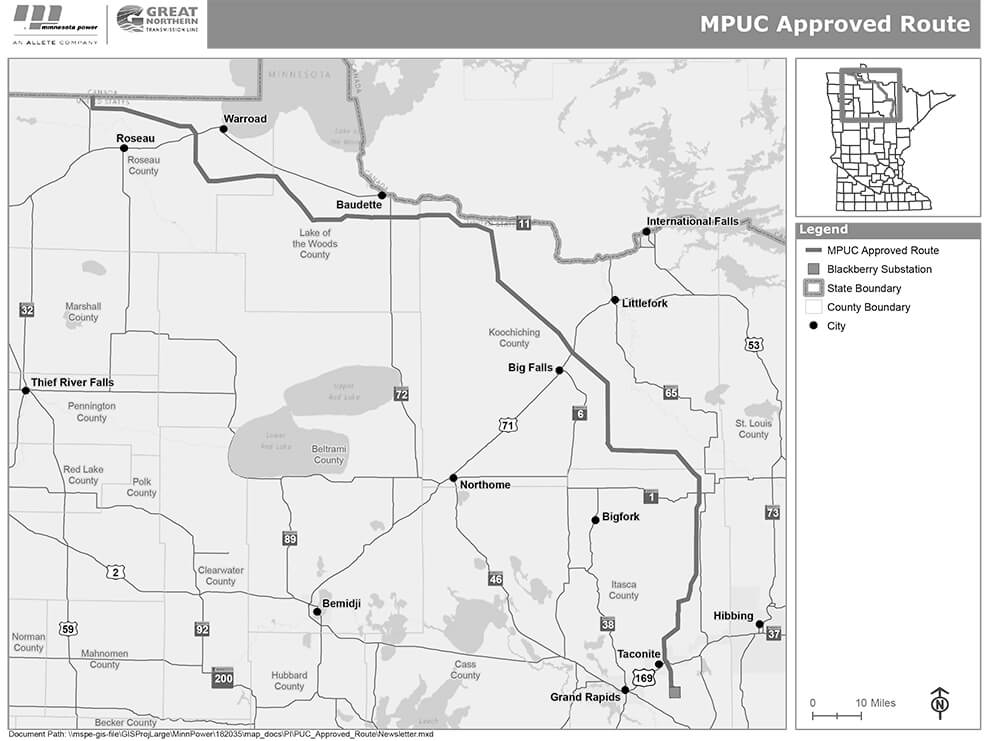
Minnesota Power’s Great Northern Transmission Line received federal approval when the U.S. Department of Energy (DOE) issued a Presidential Permit, clearing the way for building the international transmission line to deliver clean energy from Canada’s extensive hydropower resources to Minnesota while strengthening reliability of the power grid.
The Presidential Permit is the final major regulatory approval needed before construction can begin and is required because the transmission line will cross the international border between Manitoba and Minnesota and connect with Manitoba Hydro’s Manitoba-Minnesota Transmission Project.
The Presidential Permit approval is the final step in a four-year process that included comprehensive agency review and voluntary community engagement by Minnesota Power, a utility company of ALLETE, Inc.
“The Great Northern Transmission Line is a crucial link in Minnesota Power’s EnergyForward strategy of balancing renewable and traditional energy sources. Minnesota Power already has exceeded Minnesota’s 25% renewable standard, and is well-positioned to meet future decreased carbon emissions goals,” Hodnik said. “DOE’s issuance of this permit is the latest example of how we’re answering the nation’s call to transform its energy landscape, while growing ALLETE. Minnesota Power was forged from renewable hydropower 110 years ago.”
The Great Northern Transmission Line will optimize and balance the renewable resources of wind and hydropower by creating synergy between Minnesota Power’s 500-MW wind farm in North Dakota and Manitoba Hydro’s system of dams and reservoirs in Canada. Under power purchase agreements between the two companies and approved by the MPUC, Manitoba Hydro can reduce the flow of water through its hydro generators when there is excess wind power from Minnesota Power’s North Dakota wind farm.
When winds are light or calm, Manitoba Hydro can release more water — stored while the wind was blowing — through its dams and increase its hydropower production. The approved 224-mile route will cross the border between the U.S. and Canada in Roseau County in northern Minnesota, about three miles east of Minnesota Highway 89. The line will run to an expanded Blackberry electric substation east of Grand Rapids, Minnesota.
Construction is expected to begin in early 2017 on the 500-kilovolt line that will deliver 383 MW of renewable hydropower purchased from Manitoba Hydro to Minnesota Power’s customers beginning in 2020. The project is a key component of Minnesota Power’s EnergyForward strategy to reduce carbon emissions and ensure continued reliability and affordable rates while achieving a balanced energy mix of one-third renewable energy, one-third natural gas, and one-third coal.

Minnesota Power began the ROW acquisition process in early February 2016, and this chart shows the expected timeline. Learn more here.
“This is an important project for securing the availability of affordable, renewable electricity in northeastern Minnesota – especially for residential consumers, as well as our mining, manufacturing, timber, and tourism industries,” said Nolan who represents Minnesota’s 8th Congressional District.
He added: “The Great Northern Transmission Line enjoys broad stakeholder support, including local tribes, and has positive energy security and environmental implications for northeastern Minnesota, the Nation, and North America. I especially want to thank Secretary Moniz for his work and responsiveness to our recent request for a timely resolution.”
The GNTL and its clean energy benefits have been widely recognized. In June 2016, a White House press release on the North American Climate, Clean Energy and Environment Partnership that calls for the U.S., Mexico and Canada to generate 50% of their electricity from renewable resources by 2025, the GNTL was cited as one of the cross-border transmission projects that will help achieve that goal.
And in May 2014, the White House pointed out that Minnesota Power’s early coordination with other agencies and meetings with tribes, local government units and landowners was key in narrowing down potential routes for the line.
“Minnesota Power’s early work with landowners, community members, and tribal and government representatives paved the way to this permit. Through extensive meetings with stakeholders and open houses, the project development process led to the best route,” said Brad Oachs, Minnesota Power COO.
He noted that Minnesota Power also coordinated with the DOE and the state Commerce Department in the route development, refinement, and selection process to reach this regulatory milestone. The route passes through Roseau, Lake of the Woods, and Koochiching and Itasca counties in Minnesota and largely follows Minnesota Power’s preferred route, including the critical international border crossing.
Minnesota Power estimates the total cost of the project will be between $560 million and $710 million, with the company’s portion of the cost estimated between $300 to $350 million.
Filed Under: News, Policy, Projects




